Prioritizing Abandoned Mine Lands Rehabilitation: Combining Landscape Connectivity and Pattern Indices with Scenario Analysis Using Land-Use Modeling
Abstract
1. Introduction
2. Materials and Methods
2.1. Study Area
2.2. Methods
2.2.1. Patch-Scale Connectivity Approach for Identifying AML Patches for Reclamation
2.2.2. Land Reclamation Scenarios
2.2.3. Prediction of Other Land-Use Cover Changes in 2020
2.2.4. Landscape-Scale Connectivity Modeling after Reclamation
3. Results
3.1. Connectivity Values of Existing AML Patches before Reclamation
3.2. AML Transformation under Different Reclamation Scenarios
3.3. Prediction of Land-Use Changes Via the CLUE-S Model
3.4. Connectivity Modeling after Reclamation
4. Discussion
4.1. The Limitation of the Proximity Index When Assessing the Connectivity of Existing AML Patches
4.2. Selection of Landscape Metrics Characterizing Connectivity in the Post-Mining Landscape
4.3. Implications for Policy-Making of the Mine-Site Rehabilitation
5. Conclusions
Author Contributions
Funding
Acknowledgments
Conflicts of Interest
References
- Fernández-Martínez, R.; Loredo, J.; Ordóñez, A.; Rucandio, I. Mercury availability by operationally defined fractionation in granulometric distributions of soils and mine wastes from an abandoned cinnabar mine. Environ. Sci. Process. Impacts 2014, 16, 1069–1075. [Google Scholar] [CrossRef] [PubMed]
- Hu, Z.Q.; Fu, Y.H.; Xiao, W.; Zhao, Y.L.; Wei, T.T. Ecological restoration plan for abandoned underground coal mine site in Eastern China. Int. J. Min. Reclam. Environ. 2015, 29, 316–330. [Google Scholar] [CrossRef]
- Yang, S.; Cao, J.; Hu, W.; Zhang, X.; Duan, C. An evaluation of the effectiveness of novel industrial by-products and organic wastes on heavy metal immobilization in Pb–Zn mine tailings. Environ. Sci. Process. Impacts 2013, 15, 2059–2067. [Google Scholar] [CrossRef] [PubMed]
- Schröder, B. Pattern, process, and function in landscape ecology and catchment hydrology & ndash; how can quantitative landscape ecology support predictions in ungauged basins? Hydrol. Earth Syst. Sci. 2006, 10, 967–979. [Google Scholar]
- Gustafson, E.J.; Parker, G.R. Relationships between landcover proportion and indices of landscape spatial pattern. Landsc. Ecol. 1992, 7, 101–110. [Google Scholar] [CrossRef]
- Gustafson, E.J.; Parker, G.R. Using an index of habitat patch proximity for landscape design. Landsc. Urban Plan. 1994, 29, 117–130. [Google Scholar] [CrossRef]
- Gustafson, E.J.; Parker, G.R.; Backs, S.E. Evaluating spatial pattern of wildlife habitat: A case study of the wild turkey (meleagris gallopavo). Am. Midl. Nat. 1994, 131, 24–33. [Google Scholar] [CrossRef]
- Luck, M.; Wu, J. A gradient analysis of urban landscape pattern: A case study from the Phoenix metropolitan region, Arizona, USA. Landsc. Ecol. 2002, 17, 327–339. [Google Scholar] [CrossRef]
- He, H.S.; DeZonia, B.E.; Mladenoff, D.J. An aggregation index (AI) to quantify spatial patterns of landscapes. Landsc. Ecol. 2000, 15, 591–601. [Google Scholar] [CrossRef]
- McGarigal, K.; Tagil, S.; Cushman, S.A. Surface metrics: An alternative to patch metrics for the quantification of landscape structure. Landsc. Ecol. 2009, 24, 433–450. [Google Scholar] [CrossRef]
- Zhang, L.P.; Zhang, S.W.; Huang, Y.J.; Cao, M.; Huang, Y.F.; Zhang, H.Y. Exploring an ecologically sustainable scheme for landscape restoration of abandoned mine land: Scenario-based simulation integrated linear programming and CLUE-S model. Int. J. Environ. Res. Public. Health 2016, 13. [Google Scholar] [CrossRef] [PubMed]
- Leitão, A.B.; Muge, F. The role of landscape metrics in environmental planning and management of mining activities. In Proceedings of the 29th International Symposium on Computer Applications in the Minerals Industries (APCOM), Beijing, China, X., 25–27 April 2001; Heping, X., Wang, Y., Jiang, Y., Eds.; Balkema Publishers: Rotterdam, The Netherlands. [Google Scholar]
- Herzog, F.; Lausch, A.; MüLler, E.; Thulke, H.-H.; Steinhardt, U.; Lehmann, S. Landscape metrics for assessment of landscape destruction and rehabilitation. Environ. Manag. 2001, 27, 91–107. [Google Scholar] [CrossRef] [PubMed]
- Kirmikil, M.; Arici, I. The use of landscape metrics to assess parcel conditions pre- and post-land consolidation. J. Food Agric. Environ. 2013, 11, 985–989. [Google Scholar]
- Galpern, P.; Manseau, M.; Fall, A. Patch-based graphs of landscape connectivity: A guide to construction, analysis and application for conservation. Biol. Conserv. 2011, 144, 44–55. [Google Scholar] [CrossRef]
- Tischendorf, L.; Fahrig, L. How should we measure landscape connectivity? Landsc. Ecol. 2000, 15, 633–641. [Google Scholar] [CrossRef]
- Ziółkowska, E.; Ostapowicz, K.; Kuemmerle, T.; Perzanowski, K.; Radeloff, V.C.; Kozak, J. Potential habitat connectivity of European bison (Bison bonasus) in the Carpathians. Biol. Conserv. 2012, 146, 188–196. [Google Scholar] [CrossRef]
- Lechner, A.M.; Brown, G.; Raymond, C.M. Modeling the impact of future development and public conservation orientation on landscape connectivity for conservation planning. Landsc. Ecol. 2015, 30, 699–713. [Google Scholar] [CrossRef]
- Lechner, A.M.; Harris, R.M.B.; Doerr, V.; Doerr, E.; Drielsma, M.; Lefroy, E.C. From static connectivity modelling to scenario-based planning at local and regional scales. J. Nat. Conserv. 2015, 28, 78–88. [Google Scholar] [CrossRef]
- Nogués, S.; Cabarga-Varona, A. Modelling land use changes for landscape connectivity: The role of plantation forestry and highways. J. Nat. Conserv. 2014, 22, 504–515. [Google Scholar] [CrossRef]
- Ernst, B.W. Quantifying connectivity using graph based connectivity response curves in complex landscapes under simulated forest management scenarios. For. Ecol. Manag. 2014, 321, 94–104. [Google Scholar] [CrossRef]
- Pirnat, J. Conservation and management of forest patches and corridors in suburban landscapes. Landsc. Urban Plan. 2000, 52, 135–143. [Google Scholar] [CrossRef]
- Pascual-Hortal, L.; Saura, S. Comparison and development of new graph-based landscape connectivity indices: Towards the priorization of habitat patches and corridors for conservation. Landsc. Ecol. 2006, 21, 959–967. [Google Scholar] [CrossRef]
- Pascual-Hortal, L.; Saura, S. Integrating landscape connectivity in broad-scale forest planning through a new graph-based habitat availability methodology: Application to capercaillie (Tetrao urogallus) in Catalonia (NE Spain). Eur. J. For. Res. 2007, 127, 23–31. [Google Scholar] [CrossRef]
- Hoyos, L.; Cabido, M.; Cingolani, A. A multivariate approach to study drivers of land-cover changes through remote sensing in the Dry Chaco of Argentina. ISPRS Int. J. Geo-Inf. 2018, 7, 170. [Google Scholar] [CrossRef]
- Rimal, B.; Zhang, L.; Keshtkar, H.; Haack, B.; Rijal, S.; Zhang, P. Land use/land cover dynamics and modeling of urban land expansion by the integration of cellular automata and Markov Chain. ISPRS Int. J. Geo-Inf. 2018, 7, 154. [Google Scholar] [CrossRef]
- Rimal, B.; Zhang, L.; Keshtkar, H.; Wang, N.; Lin, Y. Monitoring and modeling of spatiotemporal urban expansion and land-use/land-cover change using integrated Markov chain cellular automata model. ISPRS Int. J. Geo-Inf. 2017, 6, 288. [Google Scholar] [CrossRef]
- Verburg, P.H.; Eickhout, B.; Meijl, H. van a multi-scale, multi-model approach for analyzing the future dynamics of European land use. Ann. Reg. Sci. 2007, 42, 57–77. [Google Scholar] [CrossRef]
- Verburg, P.H.; Overmars, K.P. Combining top-down and bottom-up dynamics in land use modeling: Exploring the future of abandoned farmlands in Europe with the Dyna-CLUE model. Landsc. Ecol. 2009, 24, 1167–1181. [Google Scholar] [CrossRef]
- Verburg, P.H.; van de Steeg, J.; Veldkamp, A.; Willemen, L. From land cover change to land function dynamics: A major challenge to improve land characterization. J. Environ. Manag. 2009, 90, 1327–1335. [Google Scholar] [CrossRef] [PubMed]
- Verburg, P.H.; Soepboer, W.; Veldkamp, A.; Limpiada, R.; Espaldon, V.; Mastura, S.S.A. Modeling the spatial dynamics of regional land use: The CLUE-S model. Environ. Manag. 2014, 30, 391–405. [Google Scholar] [CrossRef] [PubMed]
- Britz, W.; Verburg, P.H.; Leip, A. Modelling of land cover and agricultural change in Europe: Combining the CLUE and CAPRI-Spat approaches. Agric. Ecosyst. Environ. 2011, 142, 40–50. [Google Scholar] [CrossRef]
- Luo, G.P.; Yin, C.Y.; Chen, X.; Xu, W.Q.; Lu, L. Combining system dynamic model and CLUE-S model to improve land use scenario analyses at regional scale: A case study of Sangong watershed in Xinjiang, China. Ecol. Complex. 2010, 7, 198–207. [Google Scholar] [CrossRef]
- Zhu, Z.Q.; Liu, L.M.; Chen, Z.T.; Zhang, J.L.; Verburg, P.H. Land-use change simulation and assessment of driving factors in the loess hilly region—A case study as Pengyang County. Environ. Monit. Assess. 2009, 164, 133–142. [Google Scholar] [CrossRef] [PubMed]
- Zhang, L.P.; Zhang, S.W.; Zhou, Z.M.; Hou, S.; Huang, Y.F.; Cao, M. Spatial distribution prediction and benefits assessment of green manure in the Pinggu District, Beijing, based on the CLUE-S model. J. Integr. Agric. 2016, 15, 465–474. [Google Scholar] [CrossRef]
- Herrero, M.; Thornton, P.K.; Bernués, A.; Baltenweck, I.; Vervoort, J.; van de Steeg, J.; Makokha, S.; van Wijk, M.T.; Karanja, S.; Rufino, M.C.; et al. Exploring future changes in small holder farming systems by linking socio-economic scenarios with regional and household models. Glob. Environ. Chang. 2014, 24, 165–182. [Google Scholar] [CrossRef]
- Waiyasusri, K.; Yumuang, S.; Chotpantarat, S. Monitoring and predicting land use changes in the Huai Thap Salao Watershed area, Uthaithani Province, Thailand, using the CLUE-s model. Environ. Earth Sci. 2016, 75, 1–16. [Google Scholar] [CrossRef]
- Shrestha, S.; Htut, A.Y. Land use and climate change impacts on the hydrology of the Bago River Basin, Myanmar. Environ. Model. Assess. 2016. [Google Scholar] [CrossRef]
- Trisurat, Y.; Eawpanich, P.; Kalliola, R. Integrating land use and climate change scenarios and models into assessment of forested watershed services in Southern Thailand. Environ. Res. 2016, 147, 611–620. [Google Scholar] [CrossRef] [PubMed]
- Zhang, L.P.; Cao, M.; Xing, A.; Sun, Z.X.; Huang, Y.F. Modelling the spatial expansion of green manure considering land productivity and implementing strategies. Sustainability 2018, 10, 225. [Google Scholar] [CrossRef]
- UMass Landscape Ecology Lab. Available online: http://www.umass.edu/landeco/research/fragstats/documents/fragstats_documents.html (accessed on 5 June 2018).
- Jiang, G.H.; Wang, X.P.; Yun, W.J.; Zhang, R.J. A new system will lead to an optimal path of land consolidation spatial management in China. Land Use Policy 2015, 42, 27–37. [Google Scholar]
- Verburg, P.H.; Veldkamp, A.; Fresco, L.O. Simulation of changes in the spatial pattern of land use in China. Appl. Geogr. 1999, 19, 211–233. [Google Scholar] [CrossRef]
- Verburg, P.H.; Schulp, C.J.E.; Witte, N.; Veldkamp, A. Downscaling of land use change scenarios to assess the dynamics of European landscapes. Agric. Ecosyst. Environ. 2006, 114, 39–56. [Google Scholar] [CrossRef]
- Kline, J.D.; Moses, A.; Lettman, G.J.; Azuma, D.L. Modeling forest and range land development in rural locations, with examples from eastern Oregon. Landsc. Urban Plan. 2007, 80, 320–332. [Google Scholar] [CrossRef]
- Lambin, E.F. Modelling and monitoring land-cover change processes in tropical regions. Prog. Phys. Geogr. 1997, 21, 375–393. [Google Scholar] [CrossRef]
- Lambin, E.F.; Rounsevell, M.D.A.; Geist, H.J. Are agricultural land-use models able to predict changes in land-use intensity? Agric. Ecosyst. Environ. 2000, 82, 321–331. [Google Scholar] [CrossRef]
- Schulp, C.J.E.; Nabuurs, G.-J.; Verburg, P.H. Future carbon sequestration in Europe—Effects of land use change. Agric. Ecosyst. Environ. 2008, 127, 251–264. [Google Scholar] [CrossRef]
- Pontius, R.G., Jr.; Schneider, L.C. Land-cover change model validation by an ROC method for the Ipswich watershed, Massachusetts, USA. Agric. Ecosyst. Environ. 2001, 85, 239–248. [Google Scholar] [CrossRef]
- Gobin, A.; Campling, P.; Feyen, J. Logistic modelling to derive agricultural land use determinants: A case study from southeastern Nigeria. Agric. Ecosyst. Environ. 2002, 89, 213–228. [Google Scholar] [CrossRef]
- Bergsten, A.; Zetterberg, A. To model the landscape as a network: A practitioner’s perspective. Landsc. Urban Plan. 2013, 119, 35–43. [Google Scholar] [CrossRef]
- Pierce, S.M.; Cowling, R.M.; Knight, A.T.; Lombard, A.T.; Rouget, M.; Wolf, T. Systematic conservation planning products for land-use planning: Interpretation for implementation. Biol. Conserv. 2005, 125, 441–458. [Google Scholar] [CrossRef]
- Soltanmohammadi, H.; Osanloo, M.; Aghajani Bazzazi, A. An analytical approach with a reliable logic and a ranking policy for post-mining land-use determination. Land Use Policy 2010, 27, 364–372. [Google Scholar] [CrossRef]


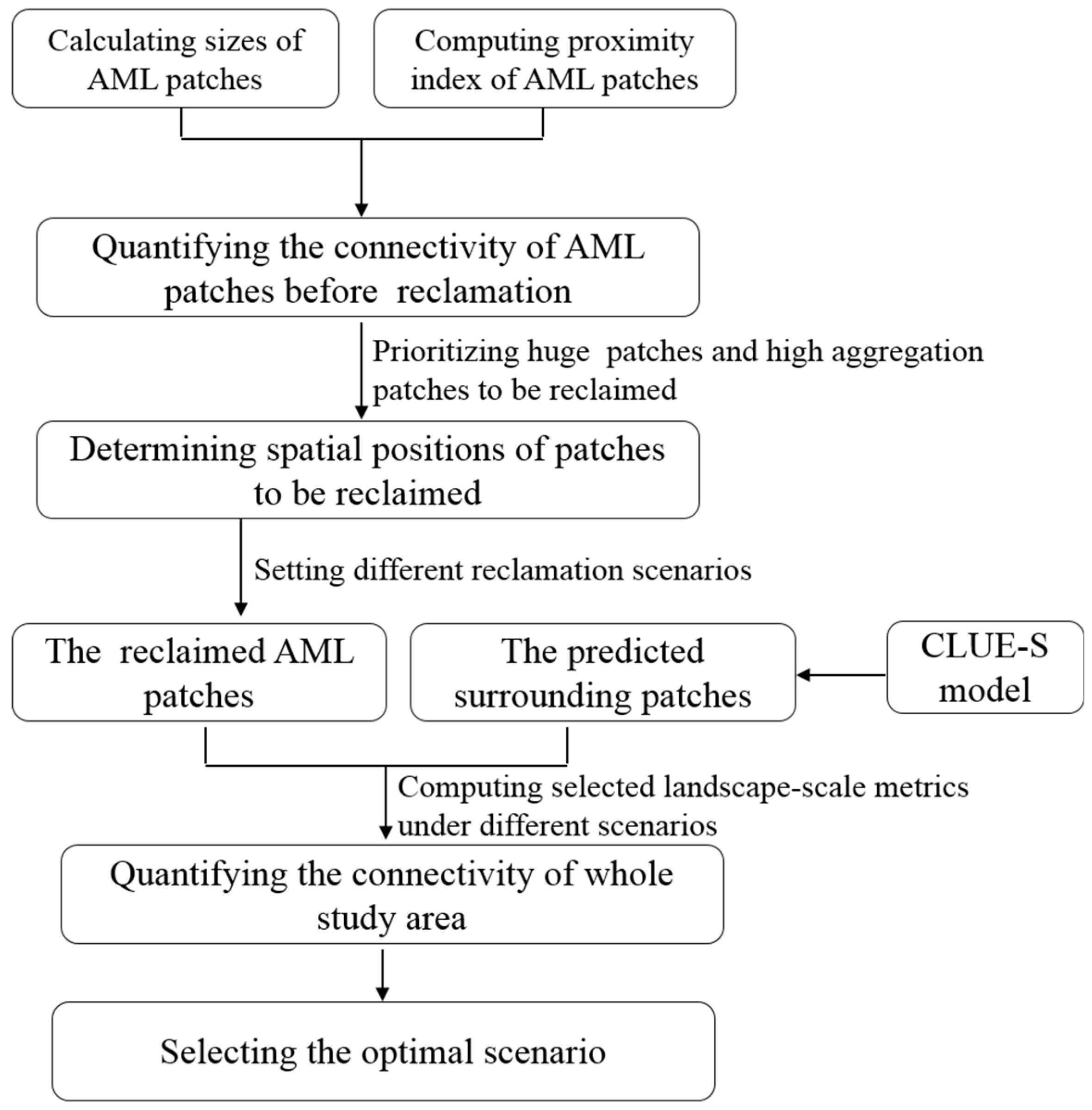
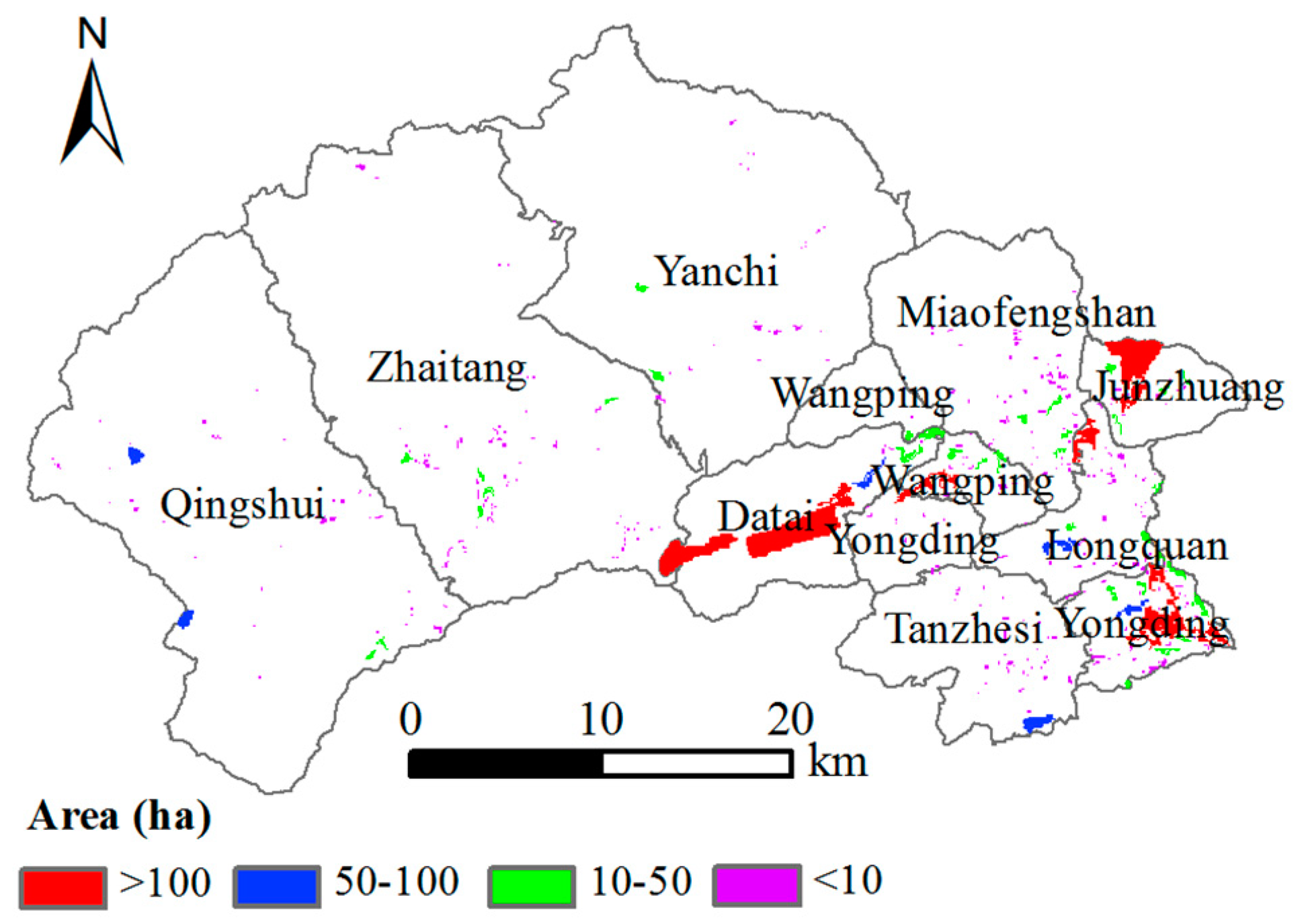
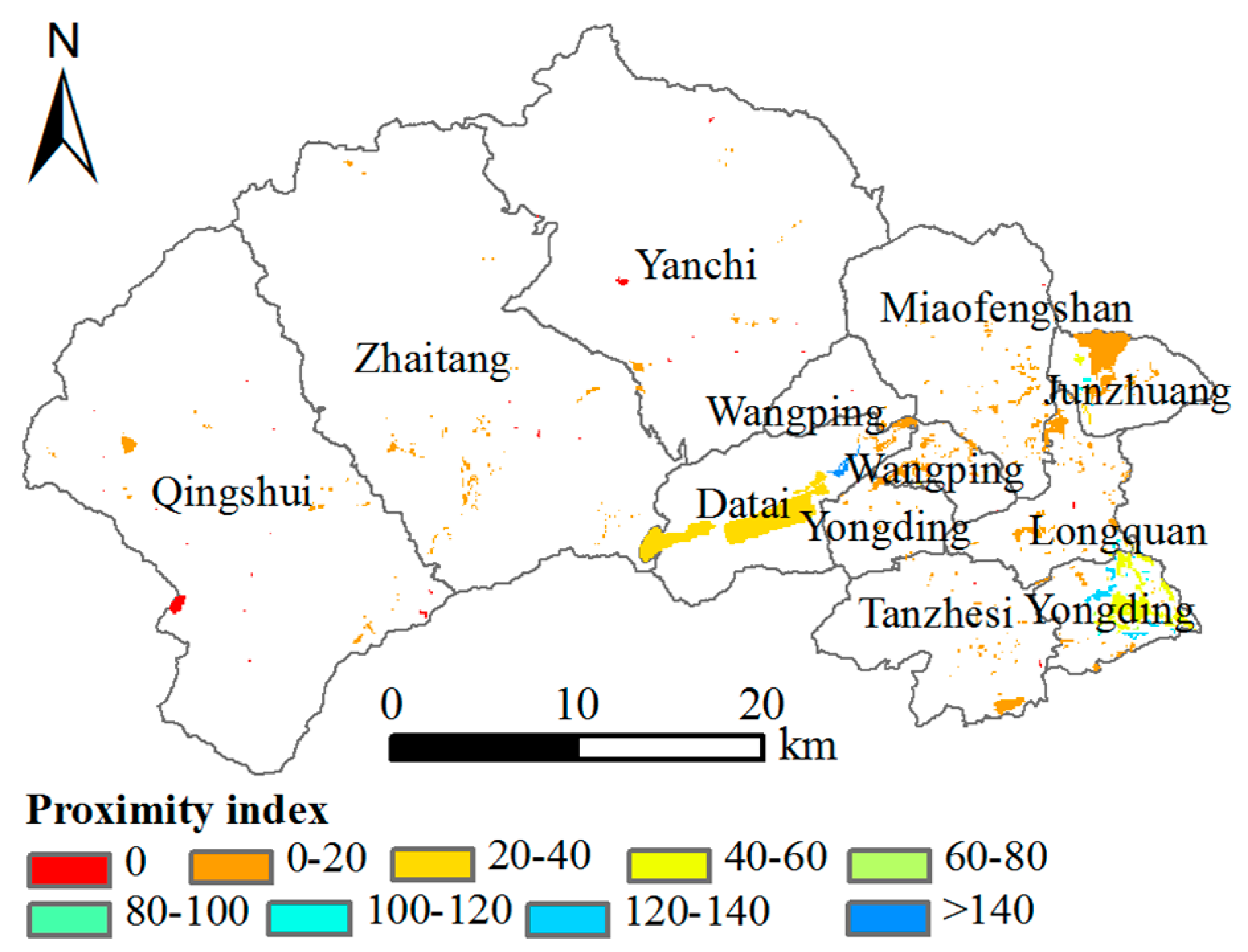
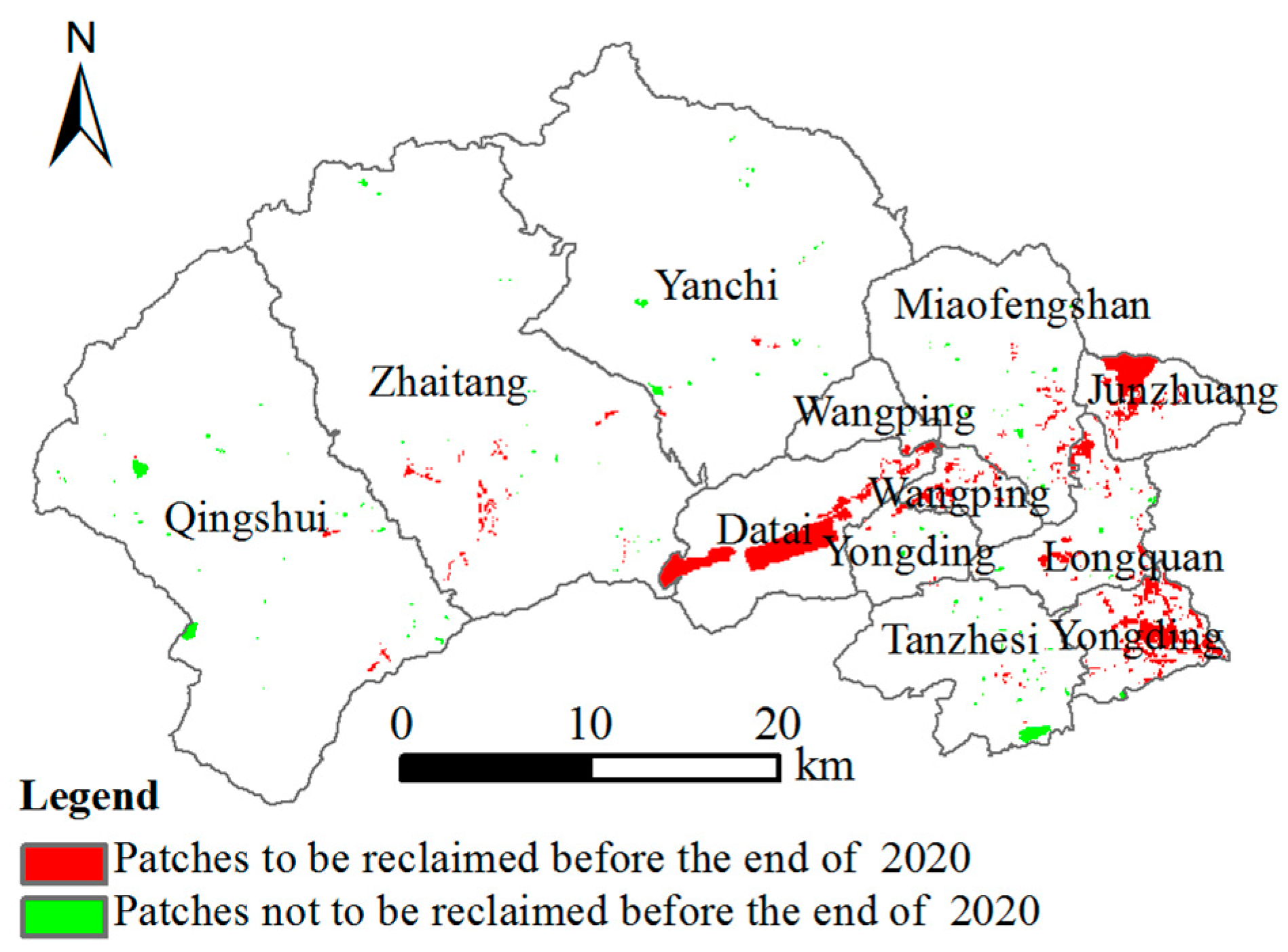
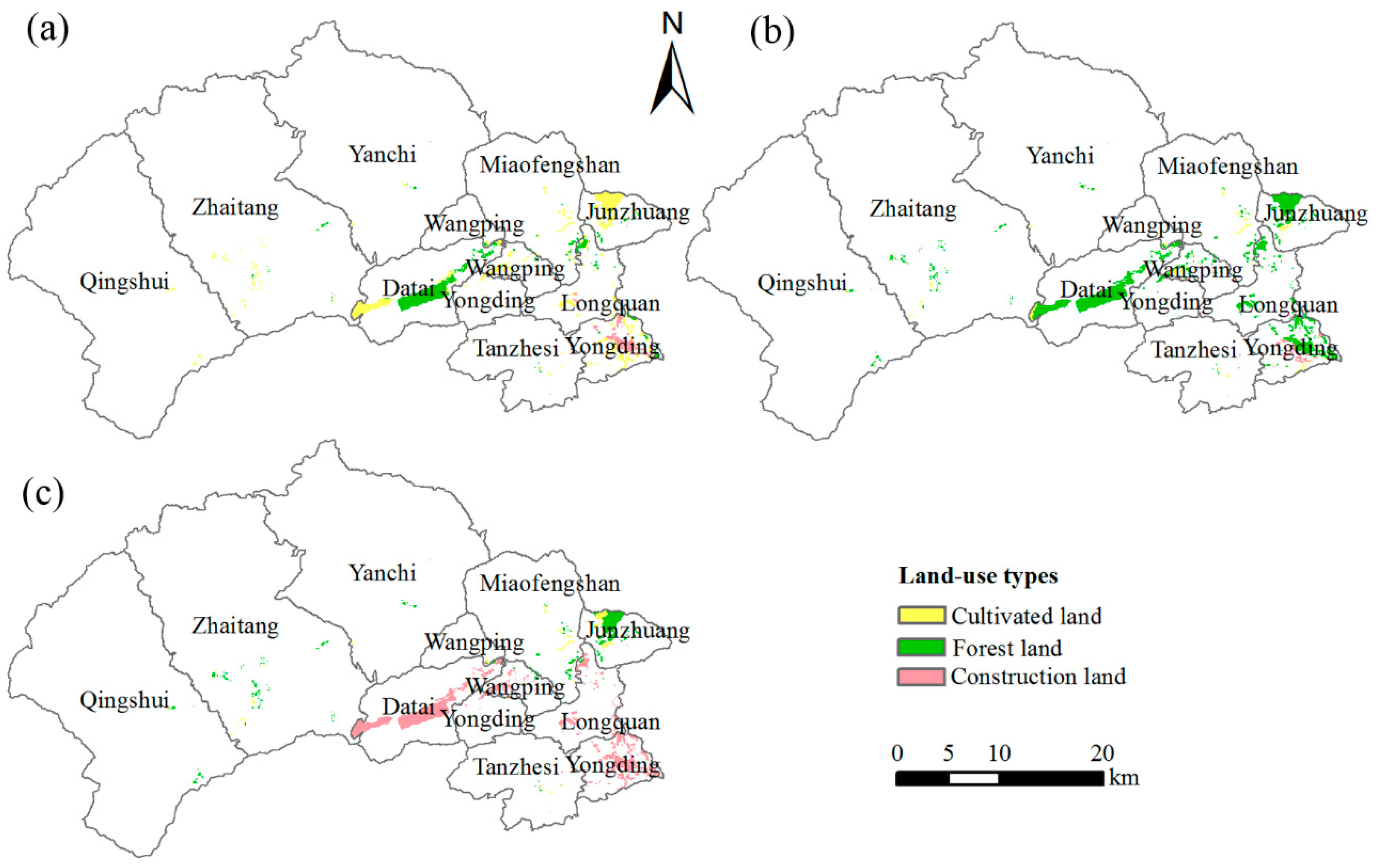

| Landscape-Scale Graph Metrics | Ecological Description | References |
|---|---|---|
| Mean patch size (MPS) | The area occupied by a particular patch type divided by the number of patches of that type. | [8] |
| Number of patches (NP) | Total number of patches in the landscape. A simple measurement of subdivision and other measures of aggregation. | [10] |
| Contagion (CONTAG) | Measuring the degree of aggregation and clumpiness of the overall landscape patterns. | [9] |
| Aggregation index (AI) | Quantification of the level of aggregation of spatial patterns. In addition, it provides a quantitative basis for correlating spatial patterns with processes that are typically class specific. | [9] |
| Shape index (SHAPE) | It measures the degree of departure of a spatial pattern from geometric shapes. Higher values indicate a shape further differing from the standard shape(square). | [9] |
| Integral index of connectivity (IIC) | The probability that two dispersers randomly located in the landscape can access each other. | [23,24] |
| Classifications of Patches 1 | Number of Patches | Rate (%) | Area of Patches (ha) | Rate (%) | Patch-Scale Proximity Index | ||
|---|---|---|---|---|---|---|---|
| Minimum | Maximum | Mean | |||||
| huge patches | 6 | 0.02 | 2319 | 56.15 | 2.43 | 42.81 | 18.22 |
| large patches | 7 | 0.02 | 432 | 10.46 | 0 | 148.14 | 40.34 |
| medium patches | 37 | 0.10 | 631 | 15.28 | 0 | 131.28 | 19.09 |
| small patches | 305 | 0.86 | 748 | 18.11 | 0 | 133.22 | 8.37 |
| Scenarios | Reclaimed Cultivated Land (ha) | Percentage (%) | Reclaimed Forest Land (ha) | Percentage (%) | Reclaimed Construction Land (ha) | Percentage (%) |
|---|---|---|---|---|---|---|
| Scenario 1 | 2092 | 58.55 | 1084 | 30.34 | 397 | 11.11 |
| Scenario 2 | 312 | 8.73 | 3078 | 86.15 | 183 | 5.12 |
| Scenario 3 | 281 | 7.86 | 721 | 20.18 | 2571 | 71.96 |
| Landscape Indices | Scenario 1 | Scenario 2 | Scenario 3 |
|---|---|---|---|
| MPS | 91.8890 | 98.5807 | 98.1131 |
| NP | 1576 | 1469 | 1476 |
| CONTAG | 68.2594 | 69.8066 | 68.4399 |
| AI | 91.6931 | 92.0096 | 91.8645 |
| SHAPE | 1.2067 | 1.1974 | 1.2021 |
| IIC | 0.6397 | 0.6644 | 0.6497 |
© 2018 by the authors. Licensee MDPI, Basel, Switzerland. This article is an open access article distributed under the terms and conditions of the Creative Commons Attribution (CC BY) license (http://creativecommons.org/licenses/by/4.0/).
Share and Cite
Zhang, L.; Zhang, S.; Huang, Y.; Xing, A.; Zhuo, Z.; Sun, Z.; Li, Z.; Cao, M.; Huang, Y. Prioritizing Abandoned Mine Lands Rehabilitation: Combining Landscape Connectivity and Pattern Indices with Scenario Analysis Using Land-Use Modeling. ISPRS Int. J. Geo-Inf. 2018, 7, 305. https://doi.org/10.3390/ijgi7080305
Zhang L, Zhang S, Huang Y, Xing A, Zhuo Z, Sun Z, Li Z, Cao M, Huang Y. Prioritizing Abandoned Mine Lands Rehabilitation: Combining Landscape Connectivity and Pattern Indices with Scenario Analysis Using Land-Use Modeling. ISPRS International Journal of Geo-Information. 2018; 7(8):305. https://doi.org/10.3390/ijgi7080305
Chicago/Turabian StyleZhang, Liping, Shiwen Zhang, Yajie Huang, An Xing, Zhiqing Zhuo, Zhongxiang Sun, Zhen Li, Meng Cao, and Yuanfang Huang. 2018. "Prioritizing Abandoned Mine Lands Rehabilitation: Combining Landscape Connectivity and Pattern Indices with Scenario Analysis Using Land-Use Modeling" ISPRS International Journal of Geo-Information 7, no. 8: 305. https://doi.org/10.3390/ijgi7080305
APA StyleZhang, L., Zhang, S., Huang, Y., Xing, A., Zhuo, Z., Sun, Z., Li, Z., Cao, M., & Huang, Y. (2018). Prioritizing Abandoned Mine Lands Rehabilitation: Combining Landscape Connectivity and Pattern Indices with Scenario Analysis Using Land-Use Modeling. ISPRS International Journal of Geo-Information, 7(8), 305. https://doi.org/10.3390/ijgi7080305




